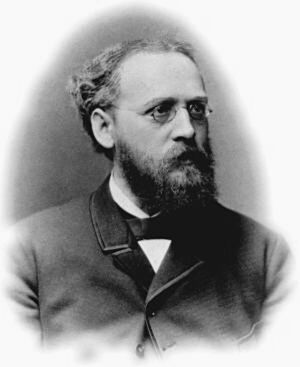Eugen Baumann facts for kids
Quick facts for kids
Eugen Baumann
|
|
|---|---|
 |
|
| Born | 12 December 1846 Cannstatt, Baden-Württemberg, Germany
|
| Died | 3 November 1896 (aged 49) Freiburg, Baden-Württemberg, Germany
|
| Nationality | German |
| Alma mater | University of Tübingen |
| Known for | Schotten-Baumann reaction |
| Scientific career | |
| Fields | organic chemistry, physiological chemistry |
| Institutions | University of Tübingen, University of Straßburg University of Berlin University of Freiburg |
| Doctoral advisor | Hermann von Fehling, Felix Hoppe-Seyler |
Eugen Baumann (born December 12, 1846 – died November 3, 1896) was an important German chemist. He made big discoveries that are still used today. For example, he was one of the first people to create polyvinyl chloride (PVC). You might know PVC from plastic pipes or window frames! He also worked with another scientist, Carl Schotten, to discover a special chemical process called the Schotten-Baumann reaction. This reaction helps chemists make new substances.
Contents
Eugen Baumann's Early Life and Education
Eugen Baumann was born in a town called Cannstatt. This town is now part of Stuttgart, Germany. After finishing high school in Stuttgart, he started working in his father's pharmacy. While working there, he also attended lectures by a famous chemist, Hermann von Fehling, at the University of Stuttgart.
To learn even more, Eugen traveled to Lübeck and Gothenburg. He worked in pharmacies in these cities. Later, he decided to study pharmacy at the University of Tübingen. He passed his first big exam in 1870. In 1872, he earned his PhD degree. He worked with another important scientist, Felix Hoppe-Seyler, for his PhD research.
Baumann's Career and Discoveries
After getting his PhD, Baumann followed Hoppe-Seyler to the University of Straßburg. There, he completed his "habilitation" in 1876. This allowed him to teach at a university. In the same year, he was offered a job in Berlin. He became the Head of the Chemistry Department at the Institute of Physiology.
In 1882, Baumann became a professor of medicine at that institute. Later, he also became a professor at the University of Freiburg. In 1895, he took over managing a science journal called Zeitschrift für Physiologische Chemie. He managed it with another scientist named Albrecht Kossel.
Baumann's Family Life
From 1883 until he passed away, Baumann was married to Theresa Kopp. Theresa was the daughter of another chemist, Hermann Kopp. Eugen and Theresa had five children together. Sadly, Eugen Baumann died at the age of 49. He passed away due to a heart problem.
Eugen Baumann's Scientific Work
Baumann's research often started with studying compounds found in urine. He was especially interested in sulfur-containing compounds. He found that certain aromatic compounds in urine came from special amino acids. An example of this is tyrosine.
He also made a big impact on the study of sulfur chemistry. He created new substances called thioacetals and thioketals. Other scientists later used these substances for things like anesthesia. Anesthesia helps people feel no pain during medical procedures.
Working with his team, Baumann also helped prove something very important. They showed that thyroxine was the active ingredient in the thyroid gland. The thyroid gland is a part of your body that helps control how you grow and use energy.
The Schotten-Baumann Reaction
While working at the physiological institute, Eugen Baumann made another key discovery. He worked with Carl Schotten. Together, they found a way to create amides from amines and acid chlorides. This special method is still known today as the Schotten-Baumann reaction. It's a very useful tool for chemists to build new molecules.
See also
- Polyvinyl chloride
- Sulfonmethane
- Tetronal
- Trional


